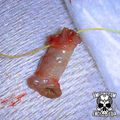Fistula Transplant Piercing
It is important to note that this procedure is considered both extremely advanced and extremely experimental. If you have experience with it, please contact us so we can expand our archives.
Fistula transplant piercing is a method of piercing otherwise unviable areas by literally transplanting a healed skin tube into place. This is usually created by taking a stretched piercing (areas like the foreskin provide an easy source of tissue) and cutting off a length of it. This is then inverted so the healed skin is on the inside, and inserted into a scalpelled piercing, thereby creating a piercing that instantly has a healed fistula.
In the example photos above, here's what you're seeing:
- A section of tissue surrounding a stretched foreskin piercing is selected for transplantation.
- After it is cut off, this tissue is turned inside out, exposing the raw flesh, and forming a tunnel that's lined with healed exterior skin.
- A new home for this piercing is scalpelled into place.
- The tube is inserted and sutured into place.
I can not emphasize enough that this is a very new technique for body modification and the jury isn't in yet. It may turn out to be revolutionary in certain contexts, or it may turn out to be a failure... So let us know if you try!
One of our readers that is also a surgeon added,
- The fistula is essentially a full-thickness skin graft in tube form. As long as the conditions are such that the graft can be supported until it has its own vasculature, it would take. It would need to be transferred to a well vascularized tissue surface with no epithelial layer. It would need to be well apposed to the underlying tissue bed. It would survive at first by imbibition, basically soaking up the interstitial fluid from the tissue bead. The process of inosculation would then take place — which is blood vessels growing into the graft from the tissue bed. Anything that would separate the graft from it's tissue bed would be detrimental to this process. Hematoma (blood collection), seroma (serum collection), or shear forces (moving it around to much in relation to the tissue bed) are all bad for graft take.
- Even if part of the transferred tube of skin died, the dermal remnants would provide more stability for the skin healing in as it would for a piercing. The individual skin cells move in from the periphery of the wound in a process called epiboly. If the whole tube died, it would be best to remove it as it could be a nidus for infection.



